 Two ways into a material world
Two ways into a material world
Essentially there are two forms of textile printing that make sense for sign-makers. Firstly, there is direct printing, which accurately describes the process and is suitable for the more basic form of textile printing, as the finish is not as pin sharp as a photograph might be but is suitable for banners and flags. Secondly, there is dye-sublimation which is more complex as it usually involves a two stage process. First a printing process onto paper and then, using a heat process, a sealing of the image onto the material. The quality is better but it takes longer. Fashion and most forms of clothing, household soft furnishings, higher quality soft signage and imagery, as well as sports and promotional clothing, are best produced using this method.

Fabric printing technology has advanced beyond all recognition from the earliest forms of block and screen printing”
Tim Egerton of Soyang Europe says: “Fabric printing technology has advanced beyond all recognition from the earliest forms of block and screen printing—and today, fabrics can be printed digitally using a number of different technologies and ink systems. In the commercial sector, the most common fabric is polyester, which is a manmade synthetic fibre (unlike natural fibres such as cotton, linen, silk, wool) and as such requires a completely different printing process—typically making use of disperse inks.”
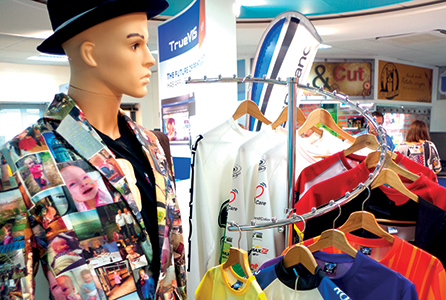
Some of the examples of what is possible in the Roland DG showroom
He continues: “Dye-sublimation is the most common, and arguably the best, way of digitally printing polyester fabrics and this can be achieved either by paper transfer or direct-to-textile methods. When printing via paper transfer, the paper is first printed with a reverse image and then passed through a heat source together with the polyester fabric onto which the image is pressed and transferred. The alternative to this is to print the fabric directly and pass it through an in-line or separate heat-fixation unit. This cuts out the paper process, but the fabric needs to have a special coating to accept the digital inks—avoiding bleeding and poor yield.”
Do your homework
Next I turned to Dean Sanger of Sabur Ink Systems of Barnsley in Yorkshire. He says: “My advice is always to do your homework, don’t just buy the very first thing that you see. In the industry there are people selling sublimation textile solutions to anyone. But there also firms like us at Sabur who have been selling them successfully year on year and retaining business by finding out from customers what type of business they are in and what their real needs are.

My advice is always to do your homework, don’t just buy the very first thing that you see”
“We have had customers coming back for years since we started back in 1998 and we’re still doing business. We retain customers as we know what we’re talking about. And that’s my advice. Do your homework but also buy from a dealer who knows the business inside out.”
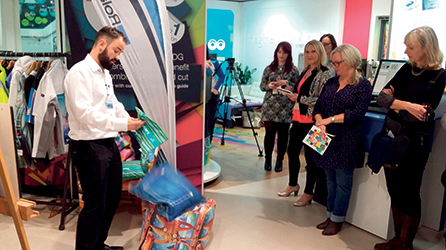
Designers are shown how digital textile printing at Roland DG can open up new markets
So, having chosen a reliable and knowledgeable dealer in textile printing kit, the next thing is to decide what you are going to print and who will be your customers.
Roland DG has some notes on that one. Mark Elvidge of the firm gives this helpful advice: “As well as seeking new business opportunities, sign-makers should not forget the fertile opportunities that exist with existing customers. After all, it is often more rewarding to upsell to an existing customer, as opposed to pursuing new leads.
“There are numerous benefits of using soft signage compared to traditional media. Sublimation prints are easily transferred to polyester-based media; the lightweight nature of the finished product means they are easier to transport and install, making it a highly attractive new offer to existing customers. Being able to fold and roll the finished product also offers reusability without a reduction in quality, both for transport and storage.”
Major brands
There are a range of makes to choose from that sign-makers will be familiar with, that offer reliable service, support, and consumables, as well as training. These include Mimaki, Mtex, Roland DG, EFI, Epson, Mutoh, Agfa, and Dgen. From large wide-format printers to smaller table top versions, the range goes from comparatively modest entry prices to many thousands of pounds.
Elvidge continues: “To support businesses considering expanding into the dye-sublimation market, Roland DG has created the Dye-sublimation Guide with Digital Inkjet; a comprehensive resource that provides an inspirational overview of the emerging and exciting market, as well as the many business opportunities it presents. Whether a company is new to the print industry, unfamiliar with the technology, or looking for tips to maximise their current investment, the guide will help businesses develop to their highest potential and show readers the range of products possible across many different markets.”
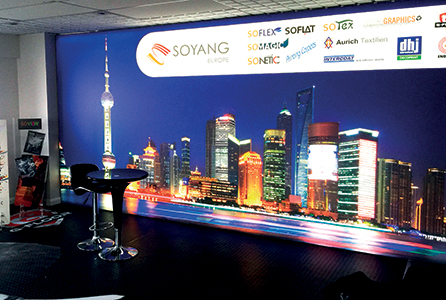
Soyang’s showroom is an Aladdin’s cave of examples that blow open the possibilities of textile printing
Sanger of Sabur Ink Systems says: “It depends on what type of system you are looking for, what tends to happen with sign-makers is if they are looking for high end results then they want indirect dye-sublimation where you print onto paper and then transfer it out the same as you do for sports, fashion, home textiles because you get the real quality.”
Hybrid Services stock the Mimaki range of printers. Their advice for sign-makers is to take a look at soft signage as it is a natural progression for them. Stephen Woodall, national sales manager, textile and apparel, notes: “Textile printing for clothing and accessories is a completely different market requiring specialist equipment and training, but there’s a buoyant market in soft signage and plenty of work to be found for a number of reasons. Soft signage is tactile and is popular because of the great visual effects it offers as a signage option. It’s also lightweight, keeping transport costs low and keeping carbon footprints to a minimum. Textile substrates in general travel well; they don’t damage easily in production, in transit or in use, and are very easy to install and change as required.”
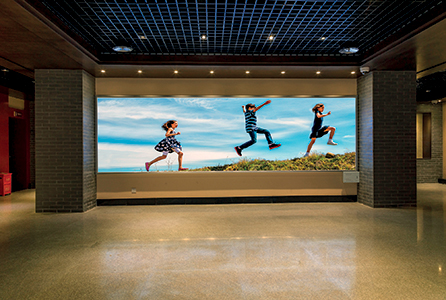
Sign-makers can tap into new revenue streams, say Hybrid Services, if they can offer textile printing
They also make the point that if sign-makers do not move into soft signage then existing customers may move their orders to a firm that does.
Clearly printing direct is attractive because of its simplicity and because it fits into the market of many smaller sign-making businesses. It is a technique that has been around for centuries long before the innovations of computer controlled digital printing in the last few years.
Applying dye to fabrics to create an image occurred after the invention of woodblock printing, when fabrics such as wall hangings did not need washing regularly as the ink would run in the washing process. Some examples date back 1,800 years to China, although the technique spread across Asia and was common place in the Western World by Medieval times.
Textiles in history
In the Americas, the Incas and Aztec civilisations both practised the technique of printing on textiles while in Europe, textile printing grew in popularity as new inks and fabrics were imported from around the world in the age of Empires. However, there has always been an issue with making the colours fast and that was where fixing solutions were pioneered. With the invention of nylon and later digital printing, it was only a matter of time before the two breakthrough processes were united. The age of soft signage is now upon us and sign-makers need to make sure they can break into the market.
Woodall of Hybrid Services comments: “What would suit most sign-makers would be to print directly to polyester for flags, and banners as in general that system serves the markets they already cover. Whereas dye-sublimation is more suited for fashion and for garments and that sort of market as dye-sublimation is a higher quality print. There are different market sectors for each technology and for the signage guys then the natural fit is printing direct to the polyester to serve the display and the flag markets.”
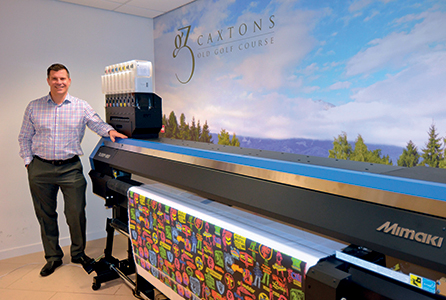
Steve Woodall has an in-depth knowledge on the do’s and don’ts of buying textile printing machinery
So, it is a choice between direct and indirect printing, a choice between good quality for flags and banners and a much higher quality for fashion, clothing, and soft furnishings, which can take a higher definition up to a photographic finish in blended colours.
Tim Egerton adds: “It is worth noting that there are some fabrics that can also be printed using UV or latex technologies. These tend to be the more dense or heavier fabrics, so if you don’t have a dedicated dye-sublimation printing system then you may be able to use some of your existing wide-format kit to dip your toe in the water.
Dye-sublimation printing technology certainly produces bright vibrant colours ideal for promotional purposes, so there is a real benefit of doing it this way. The printed fabrics—whether woven or knitted—can be used for a wide range of applications, from flags and banners, to furnishings, exhibition graphics, and sports event hoardings, even high end couture fashion.”
He also sees new avenues opening up for sign-makers who have moved into printing soft signage and textiles in general due to the advances in technology and changing attitudes to marketing for clients.
Egerton continues: “More recently, advances in fabric engineering and design have meant that printed polyesters can now be used for applications such as light boxes. This is the result of carefully combining different yarns to make the fabric as dense as possible so that you don’t see the illuminating light source behind the fabric. Aurich Textiles’ Impact Prime that Soyang Europe supplies is fast becoming the back-light fabric of choice for many of the UK’s leading print houses.
“The retail, soft signage, exhibition and event sectors are the markets where fabric printing is perhaps advancing at the most rapid pace. The UK, however, is trailing behind our mainland European neighbours. This means growth in this sector—as has been seen over the last decade—can only be expected to continue to rise. It’s really been the result of print buyers, specifiers and printing companies recognising the advantages of printed polyester fabrics, which in turn, gives printing companies the opportunity to develop a value added, higher margin revenue stream to complement existing business.”
In regard to how long the machine will last, Sanger of Sabur Ink Systems says it depends on how the machine is used and whether it is looked after and kept in good condition. He says: “Anywhere from four to seven years would be typical for the life of these printers. Some companies like to change their machines sooner because they want faster machines, higher resolutions and more efficient machines and to keep up to date with technology. Others that don’t have that need will keep them running for a longer time.
O Factoid: In the Americas, the Incas and Aztec civilisations both practised the technique of printing on textiles. O
“In they run a machine for an eight hour day then you’d probably turn around several thousand pounds a week. Take out margins then it would pay for itself in less than a year. You have to look at your ink costs, pigments, materials and so on. It will make a profit and be lucrative, but you do need the business.”
“Around 90 percent will go for direct to polyester printing. Dye-sublimation and UV is something they know about. But printing directly serves the flag market and it overlaps with their existing customer markets. So it’s a choice: do they want an all in one system where it prints and fixes all in one go or a two part process where they print, take it off and then fix it. The Achilles’ heel with the one step process is speed, as it takes longer to fix the material with an all in one process. If the operator has used any form of print technology then the print side will be familiar with the rip software, computer screen and control. The steeper learning curve comes in the fixing process, as with different textiles and inks it is more critical to get a feel of the process to eliminate mistakes.”
High quality output
Woodall of Hybrid Services adds: “For soft signage that’s tactile in nature, such as flags, then it’s dye-sublimation all the way. Direct dye-sublimation hardware, such as Mimaki’s Tx300P-1800 provides high quality output on a wide variety of fabrics and with a selection of ink sets. Printing with dye-sublimation inks onto polyester substrates at print speeds up to 68sq m/h makes this printer an ideal option for soft signage producers and is highly cost effective. The beauty of dye-sublimation printed polyester is that the inks penetrate through giving even density each side and the finish is soft making it ideal for moving items, such as feather or teardrop flags.
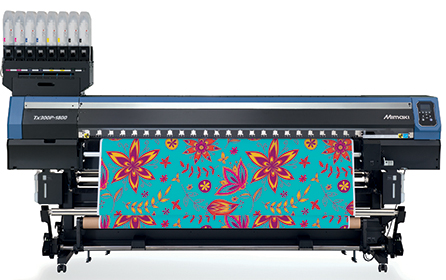
The Mimaki TX300P 1800 press is something of an industry workhorse
“If sign-makers are looking for an all-encompassing solution for printing general signage and banners, but with the flexibility to print onto coated polyester, the Mimaki UJV55-320 is a smart option. This versatile 3.2m LED UV printer provides the perfect conditions for printing backlit applications, due to the vibrancy of Mimaki’s UV inks coupled with the in-line lightbox for proofing of backlit applications on the fly. The developments that material manufacturers have achieved and the advancements in polyester technology give great effects for sign and display curing inks.”
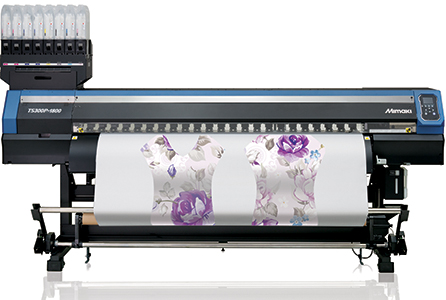
The Mimaki TS300P 1800 press has pushed the boundaries in the industry
Several themes reoccur: do your homework is the first piece of advice and do not buy the first machine you see. Another timely thought is to see the machine working in a real environment. Ask the dealer for someone who has bought the machine so you can visit them to discover how they have got on with the kit. Ask yourself who will be the operator? Will you need a new member of staff? And finally the obvious thought is have you got the work? If not, the investment may not make financial sense unless you develop a marketing policy to create the work needed to justify the investment.
Your text here...